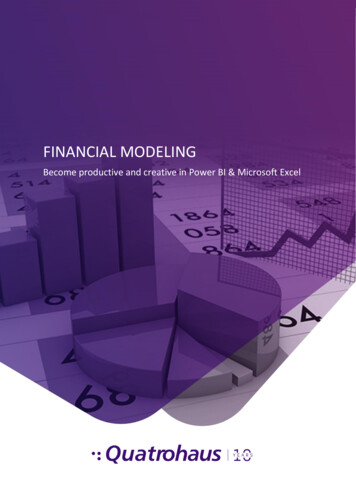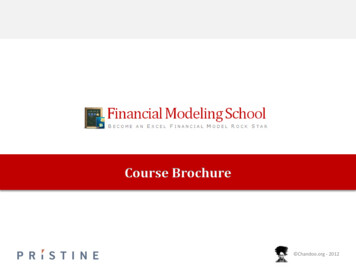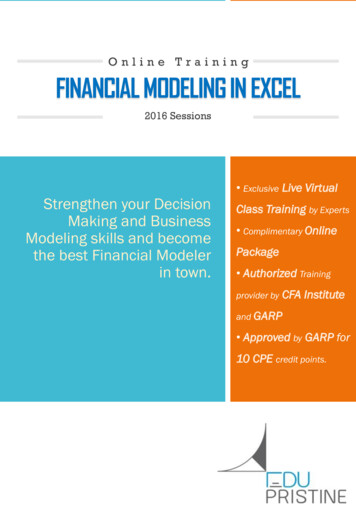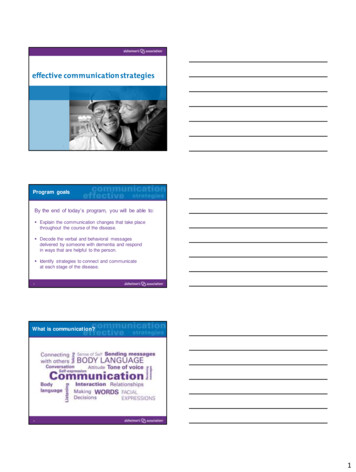
Transcription
INSTITUE OF AERONAUTICAL ENGINEERING COLLEGE(AUTONOMUS)POWERPOINT PRESENTATIONONFINANCIAL MODELINGSEMESTER -IVMs. P.BINDU MADHAVIASSISTANT PROFESSORDEPARTMENT OF MASTER OF BUSINESS ADMINISTRATION
UNIT-IUNDERSTANDING THE BASICFEATURES OF EXCEL
FINANCIAL MODELING Financial modeling is the construction of spreadsheet modelsthat illustrate a company's likely financial results inquantitative terms. Financial models can simulate the effect ofspecific variables so that the company can plan a course ofaction should they occur. Financial modeling is the process by which a firm constructs afinancial representation of some, or all, aspects of the firm orgiven security. The model is usually characterized byperforming calculations and makes recommendations based onthat information. The model may also summarize particular events for the enduser such as investment management returns or the Sortinoratio, or it may help estimate market direction, such as the Fedmodel
DEFINITION “The process by which a firm constructs a financialrepresentation of some, or all, aspects of the firm orgiven security. The model is usually characterized byperforming calculations, and makes recommendationsbased on that information. The model may also summarize particular events forthe end user and provide direction regarding possibleactions or alternatives.”
TYPES OF FINANCIAL MODEL There are various kinds of financial models that areused according to the purpose and need of doing it.Different financial models solve different problems. While majority of the financial models concentrateon valuation, some are created to calculate andpredict risk, performance of portfolio, or economictrends within an industry or a region.
DISCOUNTED CASH FLOW MODEL: Among different types of Financial model, DCFModel is the most important. It is based upon thetheory that the value of a business is the sum of itsexpected future free cash flows discounted at anappropriate rate.
COMPARATIVE COMPANY ANALYSIS MODEL: Also referred to as the “Comparable” or “Comps”, itis the one of the major company valuation analysesthat is used in the investment banking industry. In this method we undertake a peer group analysisunder which we compare the financial metrics of acompany against similar firms in industry. It is basedon an assumption that similar companies would havesimilar valuations multiples, such as EV/EBITDA.
SUM-OF-THE-PARTS MODEL: It is also referred to as the break-up analysis. Thismodeling involves valuation of a company bydetermining the value of its divisions if they werebroken down and spun off or they were acquired byanother company.
LEVERAGED BUY OUT (LBO) MODEL: It involves acquiring another company using asignificant amount of borrowed funds to meet theacquisition cost. This kind of model is being used majorly in leveragedfinance at bulge-bracket investment banks andsponsors like the Private Equity firms who want toacquire companies with an objective of selling themin the future at a profit.
MERGER & ACQUISITION (M&A) MODEL: Merger & Acquisitions type of financial Modelincludes the accretion and dilution analysis. Theentire objective of merger modeling is to show clientsthe impact of an acquisition to the acquirer’s EPS andhow the new EPS compares with the status quo. In simple words we could say that in the scenario ofthe new EPS being higher, the transaction will becalled “accretive” while the opposite would be called“dilutive.”
OPTION PRICING MODEL: On, to buy or sell the underlying instrument at aspecified price on or before a specified future date”. Option traders tend to utilize different option pricemodels to set a current theoretical value.
CUSTOMIZATION MICROSOFT EXCELENVIRONMENT: Personally I like the black colour, so my excel themelooks blackish. Your favourite colour could be blue, andyou too can make your theme coulor look blue-like. Ifyou are not a programmer, you may not want to includeribbon tabs i.e., developer. All this is made possible viacustomizations. In this sub-section, we are going to lookat Customization the ribbon Setting the color theme Proofing settings Save settings
CREATING CHARTS Charts are used to display series of numeric data in agraphical format to make it easier to understand largequantities of data and the relationship betweendifferent series of data.
Dynamic formula method Using our earlier sheet, you'll need five dynamic ranges: one for each seriesand one for the labels. Instructions for creating the dynamic range for thelabels in column A follow. Then, use these instructions to create a dynamiclabel for columns B through E. To create the dynamic range for column A,do the following:Click the Formulas tab.Click the Define Names option in the Defined Names group.Enter a name for the dynamic range, MonthLabels.Choose the current sheet. In this case, that's DynamicChart1. You can usethe worksheet, if you like. In general, it's best to limit ranges to the sheet,unless you intend to utilize them at the workbook level.Enter the following formula: OFFSET(DynamicChart1! A 2,0,0,COUNTA(DynamicChart1! A: A))Click OK.
UNIT-IISENSITIVITY ANALYSISUSING EXCEL
SENSITIVITY ANALYSIS USING EXCELThe main goal of sensitivity analysis is to gain insightinto which assumptions are critical, i.e., whichassumptions affect choice.The process involves various ways of changing inputvalues of the model to see the effect on the outputvalue. In some decision situations you can use asingle model to investigate several alternatives.In other cases, you may use a separate spreadsheetmodel for each alternative.
ONE-VARIABLE DATA For a model with numerical input and numericaloutput, use the One Input One Output feature of theSensIt sensitivity analysis add-in.
LINE CHART OR XY (SCATTER) CHART:The results of the Data table command may be displayed usingeither a Line chart type or an XY (Scatter) chart type; bothtypes have a continuous numerical vertical axis.However, the Line chart has a categorical horizontal axis,which means that the worksheet data is displayed as equallyspaced text values. Only the XY (Scatter) chart has anumerical horizontal axis.Since the input values to a data table are usually equallyspaced, you can use either chart type to display the results.When the data for the horizontal axis are not equally-spaced, itis important to use the XY (Scatter) chart type.
SCENARIO MANAGER The Scenario Manager is a great, but oftenoverlooked What-If Analysis feature of Excel thatwill let you swap multiple sets of data in a worksheetand even compare them side-by-side. This techniquecan help you decide between multiple courses ofaction or what the implications are among severalpossibilities.
SENSITIVITY ANALYSIS A sensitivity analysis is a technique used to determinehow different values of an independent variableimpact a particular dependent variable under a givenset of assumptions. This technique is used within specific boundaries thatdepend on one or more input variables, such as theeffect that changes in interest rates have on bondprices.
Random Normal Distribution
BUILDING MODELS IN FINANCE USINGSIMULATION The projection model we will be developing is one that you might find asthe starting point in many forms of analysis. The model will have these keyfeatures:u It will have historical and forecast numbers for modeling an industrialtype of company or business. Forecast numbers can be entered as ‘‘hardcoded’’ numbers (e.g., sales will be 1053 this year and 1106 next year,etc.) or as assumptions (e.g., sales growth next year will be 5 percent, etc.).u The income statement, balance sheet, and a cash flow statement followGAAP.u The balance sheet balances: the total assets must equal the total liabilitiesand net worth. This balancing is done through the use of ‘‘plug’’ numbers(see Chapter 7). With the accounting interrelationships correctly in place,the cash flow numbers will also ‘‘foot’’ (see Chapter 11), i.e., thechanges in cash flow must equal the change in the cash on the balancesheet.
UNIT-IIIEXCEL IN ACCOUNTING
EXCEL IN ACCOUNTING: Microsoft Office Excel was designed to supportaccounting functions such as budgeting, preparingfinancial statements and creating balance sheets. It comes with basic spreadsheet functionality and manyfunctions for performing complex mathematicalcalculations. It also supports many add-ons for activities such asmodeling and financial forecasting, and seamlesslyintegrates with external data to allow you to import andexport banking information and financial data to and fromother accounting software platforms.
BALANCE SHEET ANALYSIS The common figure for a common-size balance sheet analysis istotal assets. Based on the accounting equation, this also equals totalliabilities and shareholders’ equity, making either terminterchangeable in the analysis. It is also possible to use total liabilities to indicate where acompany’s obligations lie and whether it is being conservative orrisky in managing its debts. The common-size strategy from a balance sheet perspective lendsinsight into a firm’s capital structure and how it compares to rivals. An investor can also look to determine an optimal capitalstructure for an industry and compare it to the firm being analyzed.Then he or she can conclude whether debt is too high, excess cash isbeing retained on the balance sheet, or inventories are growing toohigh.
FORECASTING FINANCIAL STATEMENTS USINGEXCEL: Good forecasts must be consistent with historicalperformance and the current industry outlook. Look at historical numbers in relationship to others anduse these ratios, particularly the operating ratios, to makeyour projections. All forecasts are estimates and approximations. Spend thetime thinking and developing your ideas about the bigpicture, not the third decimal place. If the forecast looks too good to be true, it probably is. Re-examine your assumptions.
INCOME STATEMENT ACCOUNTS Revenues For industrial/manufacturing types of companies,revenues drive the other numbers in the model. Here arethings to think about as you make your forecast: Revenues are the result of three main components: price,industry growth, and market share. Isolating the pricegrowth from inflation will give you the measure forvolume growth. Understand that in the context of the economic cycle, andthen concentrate on what the drivers for future industrygrowth and market share might be.
ANALYZING FINANCIAL STATEMENTS BY USINGSPREADSHEET MODEL: Spreadsheets provide a roadmap of analysis. The maps present the bigpicture and delineate the “territories,” i.e., the major components ofanalysis. These maps help users keep the big picture in mind as they workthrough the details.The spreadsheets provide a template that can be filled in with real data forhands-on illustrations.The power of spreadsheets becomes apparent when one compares them tothe traditional sequence of text narratives, algebraic derivations, numericalexamples, and computations of metrics for real cases.Spreadsheets condense this teaching material by an order of magnitude andenable what-if analyses.In addition to condensing the material and presenting it using spreadsheets,our materials also clean up the terminology and provide a logical sequenceof otherwise disparate topics. They show how valuation drives FSA.
DETERMINING PROJECT VIABILITY Step 1: Research the Business DriversStep 2: Confirm the Alternative SolutionsStep 3: Determine the FeasibilityStep 4: Choose a Preferred SolutionStep 5: Reassess at a lower level
types of feasibility Economic feasibility, which uses economic analysis orcost/benefit analysis wherein the benefits are compared withthe cost. Legal feasibility, which deals with the legal requirements. Operational feasibility, which deals with how to solveproblems and take advantage of opportunities. Schedule feasibility, which deals with the duration of thedevelopment and completion of the system and if the scheduleor deadline is desirable. Market and real estate feasibility, which involves testing of thegeographical location of the project. Resource feasibility, which involves the amount of time setfor the project and the type and amount of resources needed.
RISK ANALYSIS IN PROJECT APPRAISAL Analyzing the time to complete a project using projectplanning tools nearly always underestimates the time tocompletion. It is not the fault of the software or of the analysts,but of the use of 'best guess' values for task durations, etc. inthe project plan. Risk analysis will allow you to avoidsystematically underestimating project costs and durations. The project risk analysis course is designed to help those whowish to apply quantitative risk analysis modeling to projectplanning problems. A project is defined as any set of tasks involving resources(human, machine, time, financial) with well-defined goals.Project risk analysis aims at identifying the risks anduncertainties that threaten the achievement of those goals orthe efficiency with which the project can be carried out.
RISK SIMULATION Risk simulation is a risk analysis technique that cameto prominence in the early 1960s (Hertz, 1964 ). Itinvolves the use of a probability distribution andrandom numbers, hence the Monte Carlo element, toestimate net cashflow figures. When discounted thesefigures sum to an estimated net present value (NPV)for a project. Repeated many times one gets adistribution of project NPV.
RESIDUAL INCOME MODEL (RIM) Along with the DDM, the residual income model (RIM)is another specialized version of a DCF used to value afirm. In its most basic form, the RIM has an equity chargethat is equal to equity capital multiplied by the cost ofequity. This is subtracted from net income to get to a residualincome figure, which is used in lieu of cash flow ordividends, as calculated in the DCF and DDM models.Residual income figures can easily be modeled andcalculated in Excel, but there are a number of steps to getto these calculations.
DETERMINATION OF VALUE DRIVERS: A value driver is an activity or capability that addsworth to a product, service or brand. Morespecifically, a value driver refers to those activities orcapabilities that add profitability, reduce risk, andpromote growth in accordance with strategic goals.Such goals can include increasing shareholder value,competitive edge and customer appeal.
DISCONTINUED CASH FLOW VALUATION: The discounted cash flow (DCF) formula is equal to the sum of the cashflow in each period divided by one plus the discount rate Weighted AverageCost of Capital (WACC) raised to the power of the period number.Here is the DCF formula: DCF (CF/(1 r) 1) (CF/(1 r) 2) (CF/(1 r) 3) (CF/(1 r) n)Where: CF Cash Flow in the Periodi the interest rate or discount raten the period number
Steps in the DCF Analysis The following steps are required to arrive at a DCFvaluation: Project unlevered FCFs (UFCFs) Choose a discount rate Calculate the TV Calculate the enterprise value (EV) by discounting theprojected UFCFs and TV to net present value Calculate the equity value by subtracting net debt fromEV Review the results
USING MODELS FOR RISK ANALYSIS Model inputs that are uncertain numbers -- we'll callthese uncertain variables Intermediate calculations as required Model outputs that depend on the inputs -- we'll callthese uncertain functions
UNIT-IVEXCEL IN PORTFOLIO THEORY
DETERMINING EFFICIENT PORTFOLIO As we know, an efficient frontier represents the set ofefficient portfolios that will give the highest return ateach level of risk or the lowest risk for each level ofreturn. A portfolio is efficient if there is no alternativewith: Higher expected return with same level of risk Same expected return with lower level of risk Higher expected return for lower level of risk
FIXED INCOME PORTFOLIO MANAGEMENT USINGEXCEL: There are income funds which have a mandate tokeep the maturity profile of the fund limited to somenumber. For E.g. Birla Dynamic normally keeps theduration near to 3. So how does one keep constantwatch on it? How does one optimize return withrespective duration? How should one allocate hisfunds to enjoy maximum convexity other things (i.e.duration, yield) remaining constant.
EXCEL IN DERIVATIVES BLACKSCHOLES IN EXCEL: The Black-Scholes formula (also called BlackScholes-Merton) was the first widely used model foroption pricing. It's used to calculate the theoreticalvalue of European-style options using current stockprices, expected dividends, the option's strike price,expected interest rates, time to expiration andexpected volatility.
The formula, developed by three economists – FischerBlack, Myron Scholes and Robert Merton – is perhaps theworld's most well-known options pricing model. It wasintroduced in their 1973 paper, "The Pricing of Optionsand Corporate Liabilities," published in the Journal ofPolitical Economy. Black passed away two years beforeScholes and Merton were awarded the 1997 Nobel Prizein Economics for their work in finding a new method todetermine the value of derivatives (the Nobel Prize is notgiven posthumously; however, the Nobel committeeacknowledged Black's role in the Black-Scholes model).
The Black-Scholes model makes certain assumptions: The option is European and can only be exercised atexpiration. No dividends are paid out during the life of the option. Markets are efficient (i.e., market movements cannot bepredicted). There are no transaction costs in buying the option. The risk-free rate and volatility of the underlying areknown and constant. The returns on the underlying are normally distributed.
Black-Scholes Formula
REAL OPTIONS VALUATION The Real Options Valuation model encompasses a suite ofoption pricing tools to quantify the embedded strategicvalue for a range of financial analysis and investmentscenarios. Traditional discounted cash flow investment analysis willonly accept an investment if the returns on the projectexceed the hurdle rate. While this is a worthwhileexercise, it fails to consider the myriad of strategicoptions that are associated with many investments. This model provides the ability to identify what optionsmight exist in your proposal and the tools to estimate thequantification of them.
KEY FEATURES OF THIS MODEL Ease and flexibility of input, with embedded help prompts. Informative 'Quick Start' menu for choosing the correct toolfor the situation. Modified Black Scholes options model to value the options todelay, expand, or abandon investments. Automatic binomial 'tree' builder model to evaluate complexstrategic options with multiple stages. Nash equilibrium Game Theory model to evaluate marketentry strategies in a competitive environment. Ability to predefine historical investment and/or industry riskprofiles to utilize across real options models. Compatible with all versions of Excel for Windows as well asExcel for Mac as a cross platform analytical business solution.
UNIT-VUNDERSTANDING SUBROUTINES ANDFUNCTIONS AND BUILDING SIMPLEFINANCIAL MODELS USING SUBROUTINESAND FUNCTION
CHECK THE RECORDED CODE The Excel Macro Recorder created some code, whilewe performed the steps in our process. In myexample, these were the steps: Open the orders file, named StationeryShort2007.xlsx Filter the list on the Data sheet, to show only theBinder orders Copy the Binder orders Create a new workbook Paste the Binder orders into the new workbook.
SUBROUTINES AND FUNCTIONS: Functions and subroutines are FORTRAN's subprograms.Most problems that require a computer program to solvethem are too complex to sit down and work all the waythrough them in one go. Using subprograms allows you totackle bite size pieces of a problem individually. Once each piece is working correctly you then put thepieces together to create the whole solution. Toimplement functions and subroutines, first write a mainprogram that references all of the subprograms in thedesired order and then start writing the subprograms. This is similar to composing an outline for an essaybefore writing the essay and will help keep you on track
TYPES OF FUNCTIONS AND SUBPROGRAMS Functions and subprograms can be grouped intoseveral categories; Intrinsic or "built-in" functions Statement or "one-line" functions (Note: This link isoptional) Function subprograms Subroutines
INTRINSIC FUNCTIONS The intrinsic functions are the set of "built-in" orlibrary functions that all versions of FORTRANprovide. These are such things as SIN, COS, EXP,. The user of these functions "passes" one or morearguments to the function. e.g.,Y COS(0.0)ABMX0.0, A and B are called "arguments" MAX(A,B)
FUNCTION SUBPROGRAMS A FUNCTION subprogram is a "mini-program", thatis, a collection of program statements which make itlook like a program. Functions, being separate entities, perform separate,specific tasks.
PASSING ARGUMENTS Actual arguments are "passed" to the subprogramsand used in place of the formal arguments. Aspreviously stated, the actual arguments may havedifferent names than the formal arguments BUT theymust agree in NUMBER and TYPE.
DECISION RULES: A decision rule is a set of conditions that classify records.The rule predicts an outcome in the target field. Viewing the decision rules helps you determine whichconditions are likely to result in a specific outcome. Forexample, consider some hypothetical decision rules thatcould predict churn. These rules might identify classifications based on theranges for customer age and number of previous claims.From these rules, you might observe that customer whohave no or 1 claim and are older than 50 are more likelyto churn. The decision rule corresponds to a branch in adecision tree.
DEBUGGING To debug a program, user has to start with a problem, isolate thesource code of the problem, and then fix it. A user of a programmust know how to fix the problem as knowledge about problemanalysis is expected. When the bug is fixed, then the software isready to use. Debugging tools (called debuggers) are used toidentify coding errors at various development stages. They are used to reproduce the conditions in which error hasoccurred, then examine the program state at that time and locate thecause. Programmers can trace the program execution step-by-step byevaluating the value of variables and stop the execution whereverrequired to get the value of variables or reset the program variables. Some programming language packages provide a debugger forchecking the code for errors while it is being written at run time.
DEBUGGING PROCESS: 1.Reproduce the problem. 2. Describe the bug. Try to get as much input fromthe user to get the exact reason. 3. Capture the program snapshot when the bugappears. Try to get all the variable values and statesof the program at that time. 4. Analyse the snapshot based on the state andaction. Based on that try to find the cause of the bug. 5. Fix the existing bug, but also check that any newbug does not occur.
DESIGNING ADVANCED FINANCIAL MODELS USINGVISUAL BASIC APPLICATION USER FORMS Automation is the buzz word in today’s corporate world.Whether it is manufacturing industry or the serviceindustry, all businesses are aiming to reduce the humanelement for critical processes and tasks to improveefficiency and output. As a finance aspirant, you will see this trend in financecompanies as well. Calculators are replaced by laptops,ledgers are replaced by spreadsheets and hard bounddocumented financial models are replaced by dashboards. If you want to pursue a career in finance, it is of utmostimportant for you to know the latest trends in yourdomain, and more importantly how to use automation inyour day to day activities as a finance professional.
Advantages of Financial Modeling using VBA 1. Excellent output with minimum input2. Speedy operations3. Accuracy4. Ease of comprehension
How to Create a Financial Model Using Excel and VBA? 1. Define the problem2. Structure the logic3. Identify the input variables4. Define the output5. Pilot run6. Record/document the model7. Monitor and update
ACTUAL MODEL BUILDING Step 1: Build Output Tabs Shell – Understand YourRequirements Step 2: Build Calculations on Paper – DetermineInputs Required Step 3: Build Input Tabs and Gather the RequiredValues
Step 4: Load Data Tables Step 5: Build Calculations off of Inputs, Drivers, andData Tables Step 6: Link Calculated values to Output Tabs andFinalize Formatting of Output Tabs Step 7: Build Your Index Tab
Step 8: Link Key Output Values to Drivers Tab toPerform Scenario and Sensitivity Analysis Step 9: Create Documentation and Finish Index Tab Step 10: Add Cell & Workbook Protection WhereAppropriate
THE END
Financial modeling is the process by which a firm constructs a financial representation of some, or all, aspects of the firm or given security. The model is usually characterized by performing calculations and makes recommendations based on that information. The m










